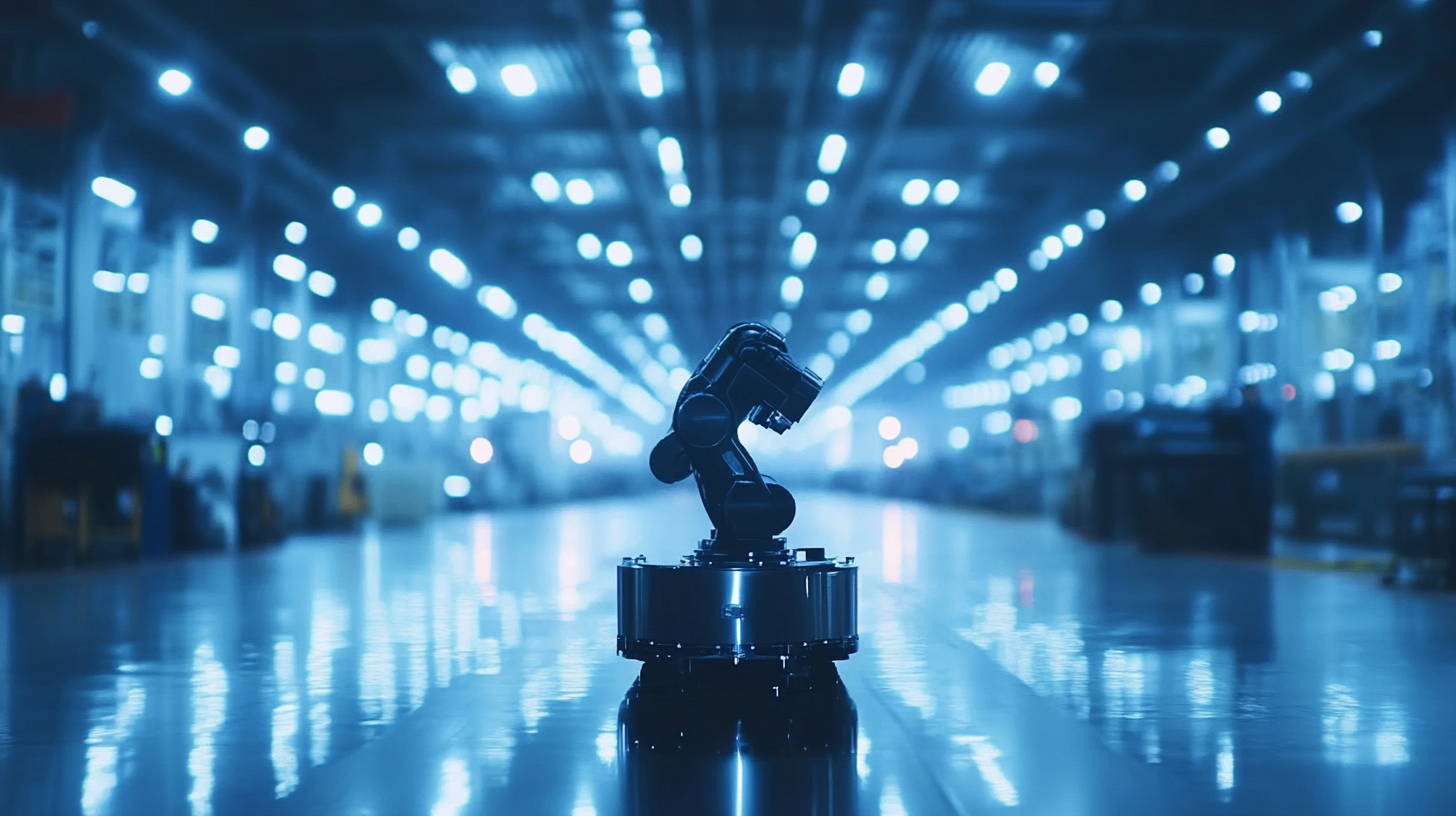Navigating Tariff Challenges in the Rise of Best CNC Robot Arm Manufacturing in China
As the global demand for automation continues to surge, the CNC robot arm manufacturing sector in China is experiencing remarkable growth despite the challenges posed by tariffs. According to a report by the International Federation of Robotics, the global market for industrial robots is expected to reach $70 billion by 2025, with a significant portion of that growth attributed to the adoption of CNC robot arms in various industries. Furthermore, a recent study indicates that China's manufacturing sector has seen a 15% year-over-year increase in CNC robot arm production, positioning the country as a formidable player in the global market. As the U.S. and China grapple with reciprocal tariff measures, Chinese manufacturers are leveraging innovation and cost-effective production methods to maintain their competitive edge. This blog will explore how the CNC robot arm industry is navigating these tariff challenges and what strategies are being employed to sustain growth amidst shifting trade dynamics.

Challenges Arising from US-China Tariff Policies on CNC Robot Arm Production
The ongoing trade tensions between the United States and China have created significant challenges for manufacturers in the CNC robot arm industry. Tariff policies implemented by both governments affect the costs of raw materials and components, making it increasingly difficult for Chinese manufacturers to remain competitive in global markets. As these tariffs escalate, the price of exporting CNC robot arms from China to the U.S. has risen sharply, often pushing potential buyers to reconsider their purchasing decisions or seek alternative suppliers from other regions.
In addition to increasing costs, these tariff challenges lead to unpredictable fluctuations in market demand. Manufacturers are forced to adapt their strategies swiftly, as delayed shipments or changes in trade regulations can have immediate impacts on production schedules and overall profitability. To navigate this volatile landscape, Chinese manufacturers must invest in efficient supply chain management, explore domestic markets, and possibly diversify their product offerings to mitigate the risks associated with reliance on the U.S. market. The ability to innovate and remain agile in response to these tariffs will ultimately determine the sustainability of their operations in an increasingly complex economic environment.

Strategies for Chinese Manufacturers to Mitigate Tariff Impact on Exports
As Chinese manufacturers of CNC robot arms confront increasing tariffs, it’s imperative to develop effective strategies to mitigate the financial impact on exports. One approach is to refine pricing strategies by analyzing the cost structure carefully and identifying areas for optimization. By enhancing production efficiency and sourcing materials locally when possible, manufacturers can reduce their overall costs, making their products more competitive even with the added tariffs. Additionally, adopting innovative technologies and automation can streamline production processes, further decreasing expenses and enabling more favorable pricing.
Moreover, diversifying export markets is essential. By targeting emerging markets and reducing reliance on traditional Western customers, manufacturers can spread risk and potentially evade higher tariff impacts from specific regions. Establishing partnerships or joint ventures with foreign firms can also be a strategic move, allowing manufacturers to tap into local markets and benefit from reduced tariffs. Finally, engaging in consistent communication and negotiation with governments can help manufacturers stay informed about policy changes and advocate for favorable trade conditions, ultimately enhancing their resilience against tariff challenges.
Navigating Tariff Challenges in the Rise of Best CNC Robot Arm Manufacturing in China
| Dimension |
Value |
| Total CNC Robot Arm Exports |
$1.5 Billion |
| Tariff Rate Increase |
15% |
| Key Export Markets |
USA, Europe, Japan |
| Manufacturer Strategies |
Local Sourcing, Price Adjustments, Enhanced Marketing |
| Projected Growth Rate |
10% annually |
| Challenges Faced |
Increased costs, Regulatory hurdles, Competitive market |
| Funding for Development |
$300 Million |
| Innovation Investment |
$150 Million |
The Role of Innovation in Maintaining Competitiveness Amid Tariff Pressures
In the face of escalating tariff challenges, the Chinese CNC robot arm manufacturing industry is turning to innovation as a vital strategy for maintaining competitiveness. According to a report by MarketsandMarkets, the global CNC machine market is projected to reach $100 billion by 2026, reflecting an annual growth rate of 6.2%. This surge in demand underscores the necessity for manufacturers to adopt cutting-edge technologies and enhance production efficiencies to counteract tariff implications.
One of the primary avenues for innovation lies in the integration of advanced technologies such as AI and automation. A study by McKinsey highlights that companies investing in AI can improve operational efficiencies by up to 30%. Chinese manufacturers are increasingly leveraging these technologies not only to reduce production costs but also to improve product quality and customization. By focusing on R&D initiatives and fostering partnerships with tech companies, manufacturers can devise more innovative solutions that not only align with global standards but also evade some tariff impacts, essentially turning challenges into opportunities for growth.
Navigating Tariff Challenges in CNC Robot Arm Manufacturing in China
This chart illustrates the export trends of CNC robot arms from China alongside the changing tariff rates over the years from 2019 to 2023. The bar graph shows a steady increase in exports despite rising tariff rates, highlighting the importance of innovation in maintaining competitiveness.
Market Trends and Opportunities in the CNC Robotics Sector in China
The CNC robotics sector in China is experiencing tremendous growth, driven by technological advancements and increasing demand across various industries. As manufacturers embrace automation to enhance efficiency and precision, the market for CNC robot arms is expanding rapidly. Companies are focusing on integrating smart technologies, such as AI and machine learning, to improve the functionality and adaptability of their robotic systems. This trend not only boosts productivity but also offers manufacturers a competitive edge in the global market.
Moreover, the shift towards customization and flexibility in production processes is opening new avenues for suppliers and manufacturers. The rise of small and medium-sized enterprises seeking tailored robotic solutions presents significant opportunities for innovation. By developing modular robotic systems that can be easily configured to meet specific needs, manufacturers can cater to a diverse clientele. As tariffs and trade policies evolve, stakeholders must remain agile, leveraging the growing demand for CNC machines while navigating regulatory landscapes to capitalize on the booming market.

Global Supply Chain Adjustments in Response to the Tariff Climate
The ongoing tariff challenges have necessitated significant adjustments in global supply chains, particularly within the CNC robot arm manufacturing sector in China. With tariffs fluctuating between 10% to 25%, manufacturers are reevaluating sourcing strategies to mitigate costs. A recent report from the International Federation of Robotics highlights that the demand for CNC robots is projected to rise by 25% annually over the next five years. This surge means that companies need to adopt more agile supply chain strategies to remain competitive, potentially looking to diversify suppliers geographically or re-engineer products to minimize tariff impacts.
Tip: Consider adopting a dual-sourcing strategy to ensure resilience in your supply chain. By establishing relationships with suppliers in different regions, businesses can better navigate tariff uncertainty and reduce reliance on any single source.
As companies adapt to these changes, investment in automation and technology becomes increasingly critical. A McKinsey analysis indicates that firms that streamline their operations through automation stand to enhance productivity by up to 30%. This shift not only helps offset some of the increased costs associated with tariffs but also positions companies for long-term growth in an evolving market landscape.
Tip: Regularly review your operational processes and integrate automated solutions where feasible, as this can lead to significant cost savings and improved efficiency over time.
Navigating Tariff Challenges in CNC Robot Arm Manufacturing
This pie chart illustrates the distribution of CNC robot arm manufacturing costs affected by tariffs in China. The percentages are based on various cost components.




